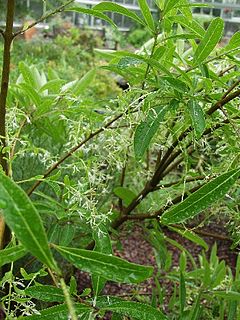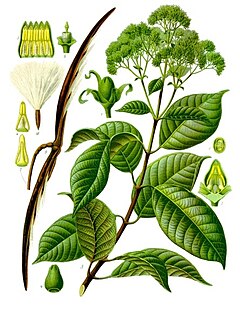
Cryptocoryne is a genus of aquatic plants from the family Araceae. The genus is naturally distributed in tropical regions of India, Southeast Asia and New Guinea.

Alocasia is a genus of broad-leaved rhizomatous or tuberous perennials from the family Araceae. There are 79 species native to tropical and subtropical Asia to Eastern Australia, and widely cultivated elsewhere.

Arisaema is a large and diverse genus of the flowering plant family Araceae. The largest concentration of species is in China and Japan, with other species native to other parts of southern Asia as well as eastern and central Africa, Mexico and eastern North America. Asiatic species are often called cobra lilies, while western species are often called jack-in-the-pulpit; both names refer to the distinctive appearance of the flower, which consists of an erect central spadix rising from a spathe.

Canarium is a genus of about 100 species of tropical and subtropical trees, in the family Burseraceae. They grow naturally across tropical Africa, south and southeast Asia, Indochina, Malesia, Australia and western Pacific Islands; including from southern Nigeria east to Madagascar, Mauritius, Sri Lanka and India; from Burma, Malaysia and Thailand through the Malay Peninsula and Vietnam to south China, Taiwan and the Philippines; through Borneo, Indonesia, Timor and New Guinea, through to the Solomon Islands, New Caledonia, Fiji, Samoa, Tonga and Palau.

Tainia, commonly known as ribbon orchids or 带唇兰属 is a genus of about thirty species of evergreen, terrestrial orchids in the distributed from India, China, Japan, Southeast Asia to New Guinea, the Solomon Islands and Queensland.

Chionanthus, common name: fringetrees, is a genus of about 150 species of flowering plants in the family Oleaceae.

Anodendron is a genus of plant in family Apocynaceae first described as a genus in 1844. It is native to China, the Indian Subcontinent, Southeast Asia, New Guinea, and some islands of the western Pacific.
- Anodendron affine(Hook. & Arn.) Druce - China, Japan, Ryukyu Islands, Philippines, Vietnam, Laos, Thailand, Myanmar, Bangladesh
- Anodendron axillareMerr. - Philippines, Borneo, W Malaysia, Java, Sumatra
- Anodendron benthamianumHemsl. - Taiwan
- Anodendron borneense(King & Gamble) D.J.Middleton - Borneo, Palawan
- Anodendron candolleanumWight - Thailand, W Malaysia, Borneo, Java, Sumatra, Philippines
- Anodendron coriaceum(Blume) Miq. - Thailand, W Malaysia, Borneo, Java, Bali, Lombok, Timor, Flores
- Anodendron gracile(King & Gamble) D.J.Middleton - Borneo, Palawan, W Malaysia
- Anodendron howiiTsiang - Guangxi, Hainan
- Anodendron nervosumKerr - Yunnan, Assam, Laos, Thailand, Vietnam, Java, Sumatra
- Anodendron oblongifoliumHemsl. - Borneo, Philippines, Maluku, New Guinea, Bismarck Archipelago, Solomon Islands, Vanuatu
- Anodendron paniculatum(Roxb.) A.DC. - India, Bangladesh, Sri Lanka, Andaman & Nicobar Is, Malaysia, Indonesia, Philippines
- Anodendron pauciflorumHook.f - Borneo, W Malaysia, Sumatra
- Anodendron punctatumTsiang - Cambodia, Thailand, Guangxi, Hainan, Sichuan
- Anodendron seramenseD.J.Middleton - Maluku
- Anodendron tubulosum(Ridl. ex Burkill & M.R.Hend.) D.J.Middleton - W Malaysia, Sumatra
- Anodendron whitmoreiD.J.Middleton - Maluku, New Guinea, Solomon Islands
- Anodendron wrayiKing & Gamble - W Malaysia

Melodinus is a genus of plant in family Apocynaceae, first described as a genus in 1776. It is native to Indomalaya, Meganesia and various islands in the western Pacific.

Homalomena is a genus of flowering plants within the family Araceae. Homalomena are primarily found in southern Asia and the southwestern Pacific, but there are a few species that are known to be indigenous to Latin America. Many Homalomena have a strong smell of anise. The name derives apparently from a mistranslated Malayan vernacular name, translated as homalos, meaning flat, and mene = moon.

Schismatoglottis is a genus of flowering plants in the Araceae family. Members of the genus are similar in appearance and growth habit to those of the genus Homalomena, but the two genera are not closely related. The primary difference is that the leaves of Schismatoglottis are not aromatic. Schismatoglottis are found primarily in tropical parts of Southeast Asia, New Guinea, and Melanesia. The majority of the species are native to the Island of Borneo.
- Schismatoglottis acutifoliaEngl. - Borneo
- Schismatoglottis adocetaS.Y.Wong - Sarawak
- Schismatoglottis ahmadiiA.Hay - Borneo
- Schismatoglottis ardeniiA.Hay - Sarawak
- Schismatoglottis asperataEngl. - Borneo
- Schismatoglottis barbataEngl. - Sarawak
- Schismatoglottis bauensisA.Hay & C.Lee - Sarawak
- Schismatoglottis bifasciataEngl. - Borneo
- Schismatoglottis bogneriA.Hay - Luzon, Mindoro
- Schismatoglottis brevicuspisHook.f. - Thailand, Malaysia, Sumatra
- Schismatoglottis calyptrata(Roxb.) Zoll. & Moritzi - Guangxi, Taiwan, Indochina, Philippines, Malaysia, Indonesia, New Guinea, Solomon Islands, Bismarck Archipelago, Vanuatu
- Schismatoglottis canaliculataEngl. - Borneo
- Schismatoglottis ciliataA.Hay - Sarawak
- Schismatoglottis claraeA.Hay - Sarawak
- Schismatoglottis clausulaS.Y.Wong - Sarawak
- Schismatoglottis clemensiorumA.Hay - Sabah
- Schismatoglottis confinisS.Y.Wong & P.C.Boyce - Sarawak
- Schismatoglottis conoideaEngl. - Sarawak
- Schismatoglottis convolvulaP.C.Boyce - Sarawak
- Schismatoglottis corneriA.Hay - Borneo, Anambas
- Schismatoglottis crinitissimaA.Hay - Borneo
- Schismatoglottis cyriaP.C.Boyce - Brunei
- Schismatoglottis decipiensA.Hay - Sabah
- Schismatoglottis dilectaS.Y.Wong, P.C.Boyce & S.L.Low - Sarawak
- Schismatoglottis dulosaS.Y.Wong - Sarawak
- Schismatoglottis ecaudataA.Hay - Sumatra
- Schismatoglottis edanoiA.Hay - Samar in Philippines
- Schismatoglottis elegansA.Hay - Sarawak
- Schismatoglottis erectaM.Hotta - Sarawak
- Schismatoglottis eximiaEngl. - Borneo
- Schismatoglottis eymaeA.Hay - Sulawesi
- Schismatoglottis ferrugineaMerr. - Sabah
- Schismatoglottis gamoandraM.Hotta - Sarawak
- Schismatoglottis gillianiaeP.C.Boyce - Brunei
- Schismatoglottis glaucaEngl. - Borneo
- Schismatoglottis grabowskiiEngl. - Kalimantan Selatan
- Schismatoglottis hainanensisH.Li - Hainan
- Schismatoglottis harmandiiEngl. - Laos
- Schismatoglottis hayanaBogner & P.C.Boyce - Sarawak
- Schismatoglottis hayiS.Y.Wong & P.C.Boyce - Sarawak
- Schismatoglottis hottaeBogner & Nicolson - Brunei
- Schismatoglottis ifugaoensisS.Y.Wong, Bogner & P.C.Boyce - Luzon
- Schismatoglottis incultaKurniawan & P.C.Boyce - Sulawesi
- Schismatoglottis jelandiiP.C.Boyce & S.Y.Wong - Sarawak
- Schismatoglottis jepomiiP.C.Boyce & S.Y.Wong - Sarawak
- Schismatoglottis jitinaeS.Y.Wong - Sarawak
- Schismatoglottis josefiiA.Hay - Sarawak
- Schismatoglottis kurziiHook.f. - Myanmar
- Schismatoglottis lancifoliaHallier f. & Engl. - Borneo
- Schismatoglottis latevaginataEngl. - Borneo
- Schismatoglottis linaeS.Y.Wong - Sarawak
- Schismatoglottis linguaA.Hay - Sabah
- Schismatoglottis longispathaW.Bull - Sarawak
- Schismatoglottis luzonensisEngl. - Philippines
- Schismatoglottis maeliiP.C.Boyce & S.Y.Wong - Sarawak
- Schismatoglottis matangensisS.Y.Wong - Sarawak
- Schismatoglottis mayoanaBogner & M.Hotta - Sarawak
- Schismatoglottis merrilliiEngl. - Luzon
- Schismatoglottis mindanaoanaEngl. - Mindanao
- Schismatoglottis miraS.Y.Wong, P.C.Boyce & S.L.Low - Sarawak
- Schismatoglottis modestaSchott - Kalimantan Tengah
- Schismatoglottis monoplacentaM.Hotta - Sarawak
- Schismatoglottis moodiiA.Hay - Sabah
- Schismatoglottis motleyana(Schott) Engl. - Borneo
- Schismatoglottis multifloraRidl. - Borneo
- Schismatoglottis multinerviaM.Hotta - Sarawak
- Schismatoglottis nervosaRidl. - Sarawak
- Schismatoglottis niahensisA.Hay - Sarawak
- Schismatoglottis nicolsoniiA.Hay - Sarawak
- Schismatoglottis patentinerviaEngl. - Borneo
- Schismatoglottis pectinerviaA.Hay - Brunei
- Schismatoglottis penangensisEngl - Penang
- Schismatoglottis petriA.Hay - Brunei
- Schismatoglottis platystigmaM.Hotta - Brunei
- Schismatoglottis pluriveniaAlderw. - Philippines, Sulawesi
- Schismatoglottis puberulipesAlderw. - Borneo
- Schismatoglottis pudendaA.Hay - Sarawak
- Schismatoglottis pumilaHallier f. ex Engl. - Borneo
- Schismatoglottis pusillaEngl. - Philippines
- Schismatoglottis pyrrhiasA.Hay - Sarawak
- Schismatoglottis retinerviaFurtado - Sabah
- Schismatoglottis roseospathaBogner - Sarawak
- Schismatoglottis samarensisA.Hay - Samar in Philippines
- Schismatoglottis sarikeensis(Bogner & M.Hotta) A.Hay & Bogner - Sarawak
- Schismatoglottis schottiiBogner & Nicolson - Borneo
- Schismatoglottis scortechiniiHook.f. - Peninsular Malaysia
- Schismatoglottis sejunctaA.Hay - Brunei
- Schismatoglottis silamensisA.Hay - Sabah
- Schismatoglottis simoniiS.Y.Wong - Sarawak
- Schismatoglottis subundulata(Zoll. ex Schott) Nicolson - Sulawesi
- Schismatoglottis tahubangensisA.Hay & Hersc. - Sabah
- Schismatoglottis tecturata(Schott) Engl. - Borneo, Riau Islands
- Schismatoglottis tessellataS.Y.Wong - Sarawak
- Schismatoglottis thelephoraS.Y.Wong, P.C.Boyce & S.L.Low - Sarawak
- Schismatoglottis trifasciataEngl. - Borneo
- Schismatoglottis trivittataHallier - Borneo
- Schismatoglottis trusmadiensisA.Hay & Mood - Sabah
- Schismatoglottis turbataS.Y.Wong - Sarawak
- Schismatoglottis ulusarikeiensisS.Y.Wong - Sarawak
- Schismatoglottis unifoliaA.Hay & P.C.Boyce - Sabah
- Schismatoglottis venustaA.Hay - Sabah
- Schismatoglottis viridissimaA.Hay - Sarawak
- Schismatoglottis wahaianaAlderw. - Seram in Maluku
- Schismatoglottis wallichiiHook.f. - Thailand, Malaysia, Borneo, Sumatra
- Schismatoglottis warburgianaEngl. - Sagapan, Mindanao
- Schismatoglottis wongiiA.Hay - Sabah
- Schismatoglottis zonataHallier f. - - Borneo

Scindapsus is a genus of flowering plants in the family Araceae. It is native to Southeast Asia, New Guinea, Queensland, and a few western Pacific islands.
Amydrium is a genus of flowering plants in the Araceae family that is native to Southeast Asia, southern China, and New Guinea.
Anadendrum is a genus of flowering plants in the Araceae family. It is native to China and Southeast Asia.

Sciaphila is a genus of mycoheterotrophic plants in the family Triuridaceae. These plants receive nutrition from fungi and neighboring trees and have less need for photosynthesis. It is widespread in tropical and subtropical regions, found in Africa, China, Japan, the Indian Subcontinent, Southeast Asia, Latin America and on various islands Pacific Islands.

Urceola is a plant genus in the family Apocynaceae, first described as a genus in 1798. It is native to China, the Himalayas, Southeast Asia, and New Guinea.
- Urceola brachysepalaHook.f. - Borneo, Java, W Malaysia, Sumatra, Philippines
- Urceola elasticaRoxb. - Borneo, Java, W Malaysia, Sumatra
- Urceola huaitingii(Chun & Tsiang) Mabb. - Guizhou, Guangdong, Guangxi, Hainan
- Urceola javanica(Blume) Boerl. - Borneo, Java, Maluku, Sumatra, Sulawesi, New Guinea
- Urceola laevis(Elmer) Merr. - Palawan, Sabah, Sulawesi
- Urceola lakhimpurensis(S.K.Srivast. & Mehrotra) Karthik. & Moorthy - Assam
- Urceola latifolia(Pierre ex Spire) Mabb. - Laos, Thailand, Vietnam
- Urceola lucida(A.DC.) Benth. ex Kurz - Myanmar, Thailand, W Malaysia, Sumatra
- Urceola malayanaMabb. - Cameron Highlands of W Malaysia
- Urceola micrantha(Wall. ex G.Don) Mabb. - Fujian, Guangdong, Guangxi, Hainan, Sichuan, Taiwan, Tibet, Yunnan, Ryukyu Islands, Assam, Bangladesh, Bhutan, Arunachal Pradesh, Nepal, Cambodia, Laos, Thailand, Vietnam, Myanmar, W Malaysia
- Urceola minutiflora(Pierre) Mabb. - Cambodia, Laos, Thailand, Vietnam
- Urceola napeensis(Quint.) Mabb. - Laos, Thailand, Vietnam, Guangdong, Guangxi
- Urceola quintaretii(Pierre) Mabb. - Laos, Vietnam, Guangdong, Guangxi
- Urceola rosea(Hook. & Arn.) D.J.Middleton - Cambodia, Laos, Thailand, Vietnam, Laos, W Malaysia, Java, Sumatra, Fujian, Guangdong, Guangxi, Guizhou, Hainan, Hunan, Sichuan, Taiwan, Yunnan
- Urceola torulosaHook.f. - W Malaysia, Sumatra, Borneo
- Urceola tournieri(Pierre) Mabb. - Yunnan, Nepal, Bhutan, Assam, Laos, Myanmar, Thailand, Vietnam
- Urceola xylinabariopsoides(Tsiang) Mabb. - Hainan, Vietnam

Phrynium is a plant genus native to China, India, Southeast Asia, New Guinea and Melanesia. It was described as a genus in 1797.

Callicarpa (beautyberry) is a genus of shrubs and small trees in the family Lamiaceae. They are native to east and southeast Asia, Australia, Madagascar, southeast North America and South America.
Apoballis is a genus of plants in the Araceae. It is native to Southeast Asia, primarily the Island of Sumatra in Indonesia. Some authorities regard this group as part of the larger genus Schismatoglottis.
- Apoballis acuminatissima(Schott) S.Y.Wong & P.C.Boyce - Sumatra
- Apoballis belophylla(Alderw.) S.Y.Wong & P.C.Boyce - Sumatra
- Apoballis brevipes(Hook.f.) S.Y.Wong & P.C.Boyce - Sumatra, Thailand, Peninsular Malaysia
- Apoballis grandiflora(Alderw.) S.Y.Wong & P.C.Boyce - Sumatra
- Apoballis hastifolia(Hallier f. ex Engl.) S.Y.Wong & P.C.Boyce - Sumatra
- Apoballis javanica(Engl.) S.Y.Wong & P.C.Boyce - Java
- Apoballis longicaulis(Ridl.) S.Y.Wong & P.C.Boyce - Sumatra
- Apoballis mutata(Scort. ex Hook.f.) S.Y.Wong & P.C.Boyce - Myanmar, Sumatra, Thailand, Peninsular Malaysia
- Apoballis okadae(M.Hotta) S.Y.Wong & P.C.Boyce - Sumatra
- Apoballis ovata(Schott) S.Y.Wong & P.C.Boyce - Sumatra
- Apoballis rupestris(Zoll. & Moritzi) S.Y.Wong & P.C.Boyce - Sumatra, Java, Bali, Lombok, Timor
- Apoballis sagittifolia(Alderw.) S.Y.Wong & P.C.Boyce - Sumatra
Teijsmanniodendron is a genus of flowering plants in the mint family, Lamiaceae, first described in 1904. It is native to Southeast Asia and Papuasia.
- Teijsmanniodendron ahernianum(Merr.) Bakh. - Borneo, Sumatra, Sulawesi, Philippines, Maluku, New Guinea, Solomon Islands
- Teijsmanniodendron bintuluenseMoldenke - Sarawak
- Teijsmanniodendron bogorienseKoord. - Thailand, Borneo, Sumatra, Sulawesi, Philippines, Maluku, New Guinea
- Teijsmanniodendron bullatumRusea - Sarawak, Sabah
- Teijsmanniodendron coriaceum(C.B.Clarke) Kosterm - Thailand, Malaya, Borneo, Sumatra
- Teijsmanniodendron glabrumMerr. - Borneo, Sumatra
- Teijsmanniodendron havilandii(Ridl.) Rusea - Sarawak
- Teijsmanniodendron hollrungii(Warb.) Kosterm - Malaya, Borneo, Sulawesi, Maluku, New Guinea, Solomon Islands, Bismarck Archipelago
- Teijsmanniodendron holophyllum(Baker) Kosterm. - Vietnam, Borneo, Malaya, Sumatra, New Guinea, Tawi-Tawi Island in Philippines
- Teijsmanniodendron latiffiiRusea - Borneo
- Teijsmanniodendron obscurinerveRusea - Sabah
- Teijsmanniodendron pteropodum(Miq.) Bakh. - Nicobar Islands, Indochina, Sumatra, Philippines
- Teijsmanniodendron punctatumRusea - Sarawak
- Teijsmanniodendron renageorgeaeRusea - Sarawak, Brunei
- Teijsmanniodendron sarawakanum(H.Pearson) Kosterm. - Borneo
- Teijsmanniodendron scaberrimumKosterm. ex Rusea - Borneo
- Teijsmanniodendron simplicifoliumMerr - Borneo, Malaya, Sumatra
- Teijsmanniodendron simplicioidesKosterm. - Borneo, Malaya
- Teijsmanniodendron sinclairiiKosterm. - Terengganu, Borneo
- Teijsmanniodendron smilacifolium(H.Pearson) Kosterm. - Borneo
- Teijsmanniodendron subspicatum(Hallier f.) Kosterm. - Borneo, Sumatra
- Teijsmanniodendron unifoliolatum(Merr.) Moldenke - Borneo, Mindanao
- Teijsmanniodendron zainudiniiRusea - Sabah



















